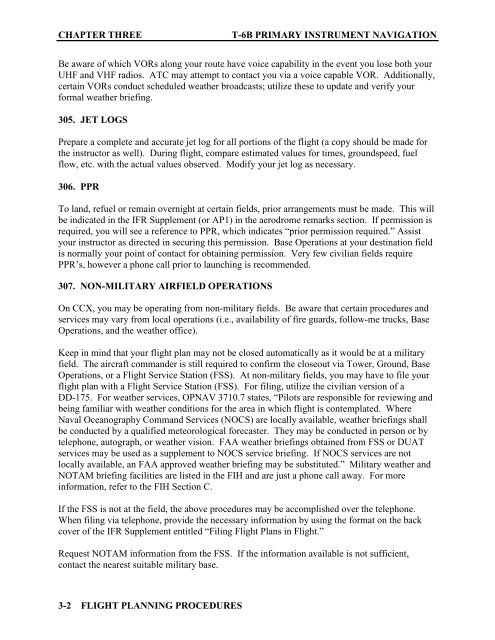Flight Training Instruction - Cnatra - U.S. Navy
Flight Training Instruction - Cnatra - U.S. Navy
Flight Training Instruction - Cnatra - U.S. Navy
Create successful ePaper yourself
Turn your PDF publications into a flip-book with our unique Google optimized e-Paper software.
CHAPTER THREE T-6B PRIMARY INSTRUMENT NAVIGATION<br />
Be aware of which VORs along your route have voice capability in the event you lose both your<br />
UHF and VHF radios. ATC may attempt to contact you via a voice capable VOR. Additionally,<br />
certain VORs conduct scheduled weather broadcasts; utilize these to update and verify your<br />
formal weather briefing.<br />
305. JET LOGS<br />
Prepare a complete and accurate jet log for all portions of the flight (a copy should be made for<br />
the instructor as well). During flight, compare estimated values for times, groundspeed, fuel<br />
flow, etc. with the actual values observed. Modify your jet log as necessary.<br />
306. PPR<br />
To land, refuel or remain overnight at certain fields, prior arrangements must be made. This will<br />
be indicated in the IFR Supplement (or AP1) in the aerodrome remarks section. If permission is<br />
required, you will see a reference to PPR, which indicates “prior permission required.” Assist<br />
your instructor as directed in securing this permission. Base Operations at your destination field<br />
is normally your point of contact for obtaining permission. Very few civilian fields require<br />
PPR’s, however a phone call prior to launching is recommended.<br />
307. NON-MILITARY AIRFIELD OPERATIONS<br />
On CCX, you may be operating from non-military fields. Be aware that certain procedures and<br />
services may vary from local operations (i.e., availability of fire guards, follow-me trucks, Base<br />
Operations, and the weather office).<br />
Keep in mind that your flight plan may not be closed automatically as it would be at a military<br />
field. The aircraft commander is still required to confirm the closeout via Tower, Ground, Base<br />
Operations, or a <strong>Flight</strong> Service Station (FSS). At non-military fields, you may have to file your<br />
flight plan with a <strong>Flight</strong> Service Station (FSS). For filing, utilize the civilian version of a<br />
DD-175. For weather services, OPNAV 3710.7 states, “Pilots are responsible for reviewing and<br />
being familiar with weather conditions for the area in which flight is contemplated. Where<br />
Naval Oceanography Command Services (NOCS) are locally available, weather briefings shall<br />
be conducted by a qualified meteorological forecaster. They may be conducted in person or by<br />
telephone, autograph, or weather vision. FAA weather briefings obtained from FSS or DUAT<br />
services may be used as a supplement to NOCS service briefing. If NOCS services are not<br />
locally available, an FAA approved weather briefing may be substituted.” Military weather and<br />
NOTAM briefing facilities are listed in the FIH and are just a phone call away. For more<br />
information, refer to the FIH Section C.<br />
If the FSS is not at the field, the above procedures may be accomplished over the telephone.<br />
When filing via telephone, provide the necessary information by using the format on the back<br />
cover of the IFR Supplement entitled “Filing <strong>Flight</strong> Plans in <strong>Flight</strong>.”<br />
Request NOTAM information from the FSS. If the information available is not sufficient,<br />
contact the nearest suitable military base.<br />
3-2 FLIGHT PLANNING PROCEDURES
















